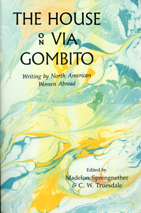My last stop in Italy was with my wonderful friends, the visual artist Patricia Glee Smith (born in Savannah, Illinois) * and her Italian husband Giangi Poli. Giangi used to create documentaries on science and politics for Italian public television; in fact, my first night there, we viewed some of his 1970 films made in the United States. The subjects were protest and the environment. Particularly powerful, I thought, was one about Staten Island where huge scows carried garbage from the other New York boroughs and dumped it. Giangi documented a fish kill along the shores of Staten Island where children flitted into the waves, nudging or lifting dead fish onto the beach, then kicking them around like beach balls. I had forgotten that along with protesting the Vietnam war, young Americans sang and marched for clean air and clean water. The legacy of that protest remains in the Clean Air and Clean Water Acts, still constantly under siege from various interest groups.
Over thirty years, Pat and Giangi have moved from the center of Rome to a hill town just inside the next northern province of Umbria. The town, Otricoli, exists on two levels: the ancient Roman city of Oriculum along the Tiber where the ruins are overgrown with vines and herbs, adjacent to vineyards, olive groves and sheep meadows; and the upper town, truly a hike from the river valley.
As I stroll around reconstructions of the upper walls, I pause by a placard describing the various stages in which the walls were built. The most ancient were constructed three or four centuries before Christ, as complements to the lower and much grander town–a kind of fortification. Those walls were made with huge blocks so well shaped that they rested together without mortar, imposing variations of the low New England walls made by carefully selecting and arranging stone upon stone. Later, in Otricoli, when the barbarians arrived in the 800s and the Tiber changed its course, the inhabitants abandoned the river site and moved up into the hills. There, medieval walls still ring the oldest part of the town–with its grey stone buildings, inner courtyards adorned with low wide arches, outside stairways, and small windows. Truly another kind of architecture than the braver and more sweeping Renaissance style with its classical balance and bold facades.
Yet, when the inhabitants moved to safety, they made regular forays on the ancient Roman site, hauling up columns and bits of freize. I pause at a corner where a low marble column fits into a medieval wall; and another where a bit of marble frieze shows an enraged eagle. Pat and Giangi’s three-story tower house sports no Roman marble, but one of its inner walls is shared with the outer medieval wall. Thus opposite their computer rises the heavy, mortared blocks of medieval protection. Once cleaning and reconstructing this outer/inner wall, Giangi unearthed a battered metal vase filled with ancient coins, probably stashed there during a siege or famine or plague.
Today the threat is global warming. Friends across the valley in San Vico face a huge, newly installed field of solar panels.
“Wonderful,” I say. “I just read that Italy may soon become one of the most important producers of photovoltaic energy in Europe.” None of these Italians and Americans living in Italy are thrilled by this. The field of solar panels blights their view of plateau and hills, of tiny stone chapels catching the sunsets.
“These panels should be installed in industrial sites,” they argue. “This is a power grab to make money.” Yes, I think, they are probably right about where the panels should be situated. But what’s wrong with individual efforts to make money? Isn’t that exactly what the United States is based on? Of course, but in cases involving elements of sky, air, earth, water, land, which are held in common, national or even international regulation are crucial. Do I or these friends in Italy truly believe that regulation will trump commercial effort? No. Regulation will probably come later, piecemeal, fought over again and again, like our Clean Water and Clean Air Acts. What curious and interesting parallels and differences exist between the U.S. and the incredibly old and compelling Tiber Valley with its hill-top towns, inhabitants with ancient lineages and more modern American residents who love its history, views, food, and companionship.
* Note: to find out more about Pat’s art visit her website. Google Patricia Glee Smith.


Janet Rose
Hey Margot, I love reading your Blog. I feel, this morning as if I am in Italy with you. Love, J.